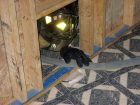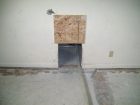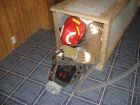
Back to Basics: January 2019
By Mark van der Feyst
Features Fire Ground TrainingIn our last issue, we began our look at self-contained breathing apparatus (SCBA) emergencies and the four different categories that they fall into.
To recap, these four categories are:
- reduced profile maneuvers
- entanglements
- equipment failures
- out of air situations
We are going to look at the first category, which is reduced profiling. The situation we need to think about here is that a firefighter is in trouble – the individual has realized that he or she is either lost, trapped, injured or caught in a rapid-fire development. The Mayday has been called and the firefighter is trying to get out of the building or to an area that is tenable.
To do this, the firefighter may have to navigate through openings that are not designed or allowable for passage. This is where the reduced profile maneuver comes into play.
The reduced profile will be dictated by the size of the opening that is available for the firefighter to get through. The opening can be any size that is not designed for human traffic or passage – a restricted opening.
How will a firefighter know the size of the opening that he or she is encountering? The firefighter will need to feel around the opening with both hands to get a three-dimensional perspective. Why two hands as opposed to one? Because our brains compute and process everything that we see in three dimensions.
If the firefighter only uses one hand to feel the opening size, the individual will only get a two-dimensional perspective. But, with both hands, the firefighter will get a three-dimensional perspective.
A good-size opening to train with is a 14-by-14-inch square opening. The width of the opening simulates the space between two studs in a wall.
Once the opening size has been determined, there are three ways in which a firefighter can reduce his or her overall profile: loosen/adjust the SCBA straps and harness, partial removal of the SCBA, and full removal of the SCBA.
Of the three options, full removal of the SCBA presents the most risk to the firefighter because the entire SCBA is coming off the firefighter’s back and is only being secured by one hand on one strap.
When the firefighter wants to gain a little bit more of an advantage, the individual can loosen the straps on his or her shoulders and at the waist belt of the SCBA. By doing this, the SCBA can be freely moved around on either side of the firefighter, allowing the individual to move it where they need to fit through a small opening.
When the firefighter requires more of a reduced profile, he or she may need to partially remove the SCBA. This will involve loosening all the straps so that they are fully extended – shoulders and waist belt. This needs to be done so that when the firefighter goes to put the SCBA back on, the individual will have no issues fitting his or her arms back through the shoulder straps and trying to re-connect the waist belt.
It is very easy to slip off the SCBA without fully extending all the straps – but trying to put it back on with the straps retracted will not be very easy.
Once the SCBA straps are loosened, the firefighter will take one of the shoulder straps off and slide the SCBA around to the side of his or her body, leaving one shoulder strap on. The side that is taken off is the side that does not have the regulator hose on it. This will allow the firefighter the ability to still breathe without compromising his or her SCBA by having no slack in the regulator hose. Once a firefighter gets through the small opening, he or she will put the SCBA back on.
When a firefighter encounters a small opening, the individual will need to remove the SCBA completely from off his or her back. The steps from the previous method apply here with the added step that the firefighter will take off both shoulder straps. Once the SCBA is off, the firefighter should point the SCBA with the cylinder valve going through first. By doing this, it gives more slack to the regulator hose and will not tug on the facepiece.
The key point is to maintain a firm grip on the strap that has the regulator hose. When a firefighter does not have a firm grip on the regulator side strap and has the cylinder pointed in the wrong direction, it adds to the overall risk. If there is a hole in the floor in front of the firefighter or at the top of stairs, the SCBA will fall through and the firefighter will lose it and the facepiece.
Once through, a firefighter will don the SCBA the same way he or she always does, tightening the shoulder straps as a minimum. I mention this because taking the time to tighten the waist belt may be the time that you need to get out and the shoulder straps are going to keep the SCBA on, not the waist belt.
These techniques need to be practised often so that confidence and comfort are built up for the firefighter doing all three of them.
Mark van der Feyst has been in the fire service since 1999 and is a full-time firefighter in Ontario. He teaches in Canada, the United States and India and is lead author of Residential Fire Rescue. Mark@FireStarTraining.com
Print this page


